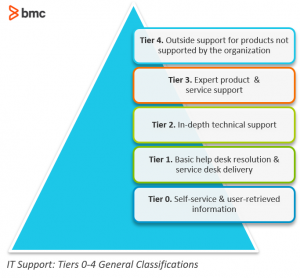A typical IT Support organization is usually organized across five support tiers:
- Tier 0 through Tier 3 IT support builds on itself and provides an escalation and resolution process for troubleshooting and fulfilling service requests.
- Tier 4 is a different animal altogether!
Tier 4 support provides all the same services as Tiers 0-3, but it provides them outside an organization’s regular IT support structure. Tier 4 support is provided by outside vendors and cloud service providers, coordinated by internal personnel.
To understand the challenges and opportunities in providing Tier 4 support, let’s look at:
- The hardware, software, and cloud support maintenance resources needed for Tier 4
- Additional considerations when contracting for and using Tier 4 support in a cloud services environment

What’s tier 4 IT support?
Tier 4 support is powered by software, hardware, and cloud maintenance contracts and statements of work (SOWs). Maintenance contracts and SOWs lay out the services and support provided, including:
- What is supported
- Support hours
- Rates
- Legal obligations
- Service level agreements (SLAs)
SOWs are used to purchase regular maintenance and troubleshooting services (break/fix), as well as contracting for project work when you want to install, configure, or upgrade new and existing services.
In a cloud services environment, maintenance may be covered under a monthly, quarterly, or yearly subscription or by a contract/SOW, depending on the cloud services you’re contracting for. The support requirements may be explicitly laid out as above, or they may be covered by blanket SLAs the vendor provides for all its customers (sometimes used in subscription cloud services).
Tier 4 support requires your support organization to purchase and indefinitely maintain many support contracts for critical items, including:
- Operating system support
- Server maintenance
- Cloud services support
- Application support including programming and troubleshooting, for enterprise, special purpose, network, and desktop software
- Network appliance configuration and maintenance for items such as routers, firewalls, switches, Web filtering hardware, etc.
- Copier maintenance
- PC maintenance
- Email systems
- Laser, bar-code, and high-speed impact printers
- Scanners
- Cell phones
- Telecommunications lines
- UPS systems and generators
- Air conditioners
All of which adds up to a fair number of maintenance contracts and SOWs that need to be tracked for tier 4 support.
| Support tier | Purpose |
|---|---|
| Tier 0 Self-service & user-retrieved information | Provide users with self-service tools to solve problems themselves and to escalate requests to Tier 1, if needed. Tier 1 is generally Web or app-based support. |
| Tier 1 Basic help desk resolution & service desk delivery | Support for basic customer issues that solve known problems and fulfill service requests. |
| Tier 2 In-depth technical support | Uses experienced and knowledgeable engineers to assess issues and provide solutions not available in tier 1 |
| Tier 3 Expert product & service support | Highly skilled product specialists-including product owners and creators-find root causes for difficult problems and decide whether a new fix will be created |
| Tier 4 Outside support for products not supported by the organization | Contracted support for items provided by the organization but not directly supported by the organization |
Setting up tier 4 supports
That means the first item of business when you add any new service, equipment, or software to your network is to identify, set up, and document the following:
- Identify what type of support is needed: tier 0-3 (inside) or tier 4 (outside vendor).
- Determine who your tier 4 support organization will be for the item.
- Negotiate and get a maintenance or SOW quote for the vendor’s services. Note: this may not be available or needed for certain cloud services.
- Determine cost and dates, including what costs are necessary to deliver this service and what date range the contract covers.
- Get approval and add the new expense into your budget. Since tier 4 support is an IT service rather than capital, it will probably be budgeted as an operating expense item (OpEx). Cloud services and support will mostly be budgeted as OpEx.
- Determine how you will track and report on incidents or requests sent to an outside vendor. Service management platforms such as BMC Helix ITSM provide incident tracking, problem management, change management, service request management, and a configuration management database (CMDB) that provide all the capabilities you need for tracking and reporting.
Tier 4 support requires a fair amount of contract management and repeatable budgeting events. Each support contract has its own documentation, payment due date, and contract expiration date.
To confuse matters, you may have several support contracts with the same vendor, with each contract having different expiration dates. In a single vendor-multiple contract situation, it’s helpful to contact and arrange for all services to be co-terminus, meaning they all expire at the same time each year.
When to drop tier 4 support for a particular item
You should think carefully before halting a support contract, particularly for expensive items.
Many providers price support at about 20-25% of the purchase price, such that every 4-5 years you wind up paying for the product a second time. Some shops are tempted to skip paying support for items that never change or for program maintenance that they believe they will never use.
But beware. Many vendors have policies that if a customer lets support lapse, the customer must pay yearly support all the way back to the time they stopped paying support…sometimes with penalties.
A good rule of thumb is to buy maintenance for any items that you either don’t want to or cannot maintain yourself or that are too expensive to replace. The worst feeling in the world is when you must replace an expensive IT item or pay back maintenance because you didn’t keep up with the maintenance contract after the first year’s maintenance runs out.
Tier 4 support & cloud services
Be careful when dealing with Tier 3 and Tier 4 support for troubleshooting issues involving cloud services. Traditional IT support contracts are built around providing support either for:
- Products you “own”, such as a piece of on-premises software you’ve licensed or computer hardware you own/lease such as PCs, laptops, servers, and network equipment
- Professional services you’ve contracted for, such as support for using various software packages, printer, and scanner support, etc.
Under traditional IT support contracts—product and professional service support when the supported item resides on-premises—fall neatly into Level 0-4 IT support tiers.
Cloud services frequently break this mold. Cloud services don’t involve products you “own” or professional services you’ve contracted for. A cloud service is a right to access a service on another company’s network. And that complicates cloud service tier 4 support.
Think of a company that buys cloud services for Amazon Web Service (AWS) infrastructure hosting. For AWS hosting, you may configure an EC2 Linux instance and databases to host a custom-written pricing app. The app has an issue that can’t be solved by levels 0-2 support, and you need to escalate for a fix.
In this situation, the question becomes:
- Is the fix a problem within the AWS provided operating system or database, which may involve tier 4 support and escalation to Amazon?
- Or is the problem with your custom-written application, which would be solved by escalation to IT tier 3 support?
For AWS cloud services, it’s not obviously clear which escalation path should be followed—tier 3: organizational experts versus tier 4: outside support. You’re using an AWS EC2 instance, but AWS has nothing to do with the software you’re running.
Advancing cloud service issues past tier 2 support may require a determination of who owns the issue and whether it should be escalated to tier 3, tier 4 for the cloud service, or tier 4 to another vendor whose software is being used under the cloud service (maybe the consultant who wrote the custom app running on AWS EC2).
Tier 4 support gets more complicated for cloud service issues. Support group assignment may need additional analysis to determine what IT support tier (tier 3 or 4) and what support group an issue with a cloud service element will be assigned to. It won’t always be obvious who should resolve IT cloud service support issues. And you may have to factor IT tier 4 support determination into your support structure.
Auditing & renegotiating maintenance payments
Finally, don’t forget to audit your support payments. As noted above, maintenance providers tend to price maintenance support at about 20-25% of the original purchase price or charge. But that won’t stop vendors from raising support costs year-to-year or reclassifying support costs into a more expensive maintenance tier.
For cloud support, where maintenance may be factored into a subscription fee or a contract, prices may increase on a yearly basis due to the vendor’s pricing plan and may increase sporadically, depending on how you’re billed.
Always check your tier 4 support bills against the contract or the vendor’s current pricing policy. Be sure to check any monthly subscription charges that may be auto paid to watch for price changes. Make sure the vendor is charging the agreed upon contract price or current pricing policy.
If there’s a billing increase, it may be due to an agreed upon price increase clause (for example, the contract may specify a percentage increase due each year) or a change in subscription fees. Bring up any price increases that aren’t triggered by the contract.
(Avoid vendor lock-in with these 10 checks.)
BMC is a service management leader
If you’re interested in more information about IT support levels and tier 4 support, meet BMC Software. We’re leaders in service and operations management, and we’ve been helping enterprises for more than 40 years. BMC Helix is our integrated service and operations management portfolio for modern enterprises.







